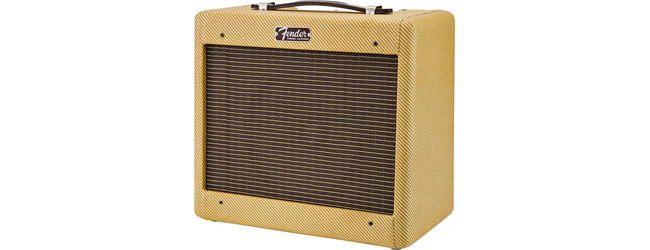
It’s a sound that is so deeply embedded in music history that it can never be undone. The little Fender Champ has made a fantastic music in garages, basements, bars, legion halls, recording studios and arenas around the world. So significant and desirable is its tone that its parent company has reissued the original design even down to the same cabinet styling decades after it was first introduced.
But let’s back up for a minute. All this didn’t happen overnight. Leo began making amps with the “K&F” line in 1945. The next step was the “Woodie” series with plain stained cabinets. This all lasted from 1945 through 1947 and sales were less than strong. By 1948, however, things were beginning to pick up a bit, and though Fender was still a small company, his lap steel guitars had begun to take hold with country players. To compliment his guitar sales, Leo redesigned his amplifier line, and in 1948 issued the first “tweed” amps, the Deluxe, Princeton and Champion 800.
Notice the lack of a “Champ” amplifier. That’s right, the little Champ didn’t actually become the “Champ” until 1955, a full seven years after its introduction. Names notwithstanding, it was the bits behind the badge that gave the amp its sound, and the Champion 800 delivered. The amp was of class A design with its tone voiced through an 8” speaker pushed by a single 12AX7 preamp tube and 6V6 power tube. There was one knob, volume. The whole thing pumped out a massive three watts. It doesn’t get much simpler than that, but for the Champ that was all that was needed. It was these earlier tweed models that were highly prized by legends such as Eric Clapton and Keith Richards, Clapton recording the Derek and the Dominoes “Layla” sessions using a Champ. Not only is the Champ good for guitar, but countless harmonica players have used Champs to craft an amazing overdriven crush that is so desired in amplified harp playing.
The Champion 800 became the Champion 600 a year later with a six-inch speaker. It would retain the six-incher for much of its life, though the ’58 model had an eight-inch speaker. The Champ remained in production until 1982, and then was reintroduced in 2006. There have been several permutations of the Champ over the years, including a Vibro Champ with tremolo in 1964 and Vibro Champ XD in 2007 that included a digital signal processor. However, simplest is still best for many people, and Fender is now reproducing a repop of their original piece called, appropriately, the ’57 Champ. Even if you can’t afford an original Champ, with so many variants over the years, both new and used models make it possible for nearly anyone to afford a taste of the sound that Leo first created back in 1948.


